Excellent for award interpretation, but limited scheduling flexibility.
Verdict: 6.8/10
After using Tanda, I find it offers an easy-to-use interface with strong award interpretation and compliance features. Its time tracking features strengthen its scheduling capabilities, and its audit-ready templates and applicant tracking system are nice additions.
But compared with other tools, Tanda lacks features like advanced training and task management, its mobile app is limited, and its time clock can feel clunky.
The per-user pricing model seems quite costly, and the lack of a free plan is a disadvantage for small businesses.
If you’re looking for basic scheduling and payroll management that complies with industry awards, I think it’s a good option. For features beyond that, you may want to consider another tool.
Key Features:
- Rostering: Create and share rosters, validate for compliance risks and enable employees to swap or claim shifts.
- Award Interpretation: Stay compliant with Australian labour laws using award templates that set base pay, define hours and flag payroll issues.
- Performance Management: Run performance reviews and engagement surveys, collect feedback and respond to employee insights.
- Live Insights: View real-time data on sales, labour costs and foot traffic, and compare performance across locations.
- Leave Management: Streamline leave requests, approvals and compliance while optimizing shift coverage.
- Tanda Hire: Attract and recruit new talent with an integrated applicant tracking system (ATS) and talent pool notifications.
- Employee Onboarding: Send, sign and store contracts digitally, with automatic employee syncing to payroll and scheduling.
- Contracts & Policies: Distribute contracts and policies, track signatures and store in the Document Hub.
- Mobile App: Manage time tracking, rosters, and leave
Pros
- Easy-to-use interface
- Award interpretation for Australian labour laws
- Integrated ATS
- Reliable customer support
Cons
- High per-user cost and no free plan
- Lack of interactive training features
- Limited mobile app
- Limited to Australian businesses and best only for hourly teams
Tanda Pricing
Tanda offers separate pricing for its 3 core feature suites—Workforce Management, Payroll, and HR.
Pricing tiers aren’t listed on the site. Pricing is available only upon request: You must fill out a form with details about your industry and how many workers you expect your business to have eventually.
I filled out details about a hospitality business with 50 workers. Then, I was put in touch with a sales rep, who granted me access to a free 14-day trial.
With my 14-day free trial, I gained access to an in-app pricing calculator with specific costs. I used this calculator to explore pricing.
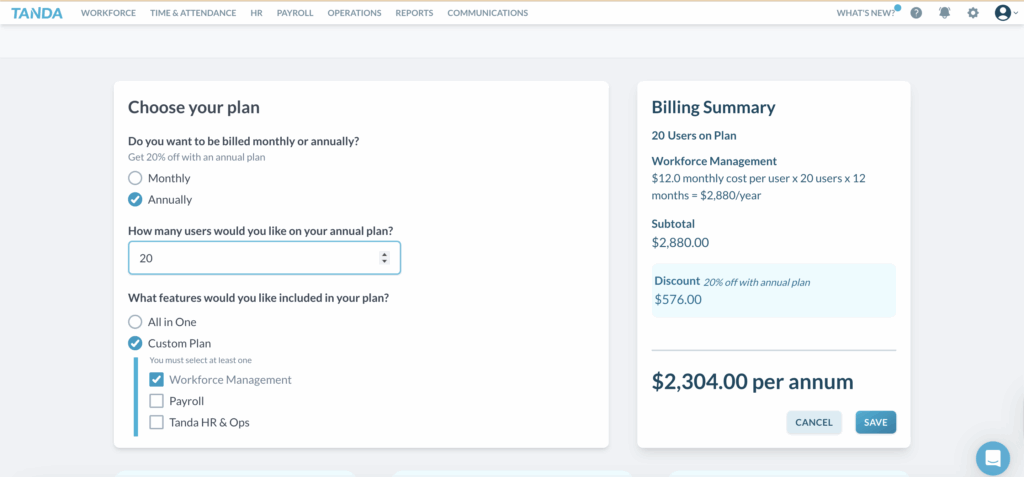
I’m not sure if these costs are the same for all trial users, or if they’re based on the information these users give to the sales rep.
Here’s what I do know:
Pricing depends on your user base and chosen add-ons.
You must choose the Workforce Management module. You can either:
- Select a custom plan with the Workforce Management module (it’s pre-selected) and include Payroll and/or HR as add-ons, or
- Select the All-in-One plan that includes all 3 feature sets.
Pricing is per user, billed either monthly or annually, with a 20% discount if you opt for annual billing.
Here’s a breakdown of what pricing for me looked like, plus the features in each suite:
Plan | Workforce Management | Workforce Management +HR (add-on) | Workforce Management + Payroll (add-on) | All-in-One |
Billed monthly per user | $12 AUD without add-ons $10 AUD with add-ons | $14 AUD | $14 AUD | $16 AUD |
Billed annually per user (20% discount) | $115.20 AUD | $134.40 AUD | $134.40 AUD | $153.60 AUD |
Who it’s for | Businesses managing rosters, leave, and attendance for hourly workers | Businesses that also want hiring, onboarding, and performance features | Businesses that also want payroll processing, tax management, and other features | Businesses that want all 3 functions |
| Key features | RostersTimesheetsLeave managementEmployee onboardingReportsTanda Time Clock AppEmployee Scheduling Mobile App | Performance ReviewsFormsWarningsTrainingIncident reportingThe Employment Law Handbook | Auto-calculations of tax and superannuationEmployee payslipsEmployee payroll reportsSingle-touch payrollDetailed payroll journals | All the features in the preceding plans |
Many of Tanda’s competitors, like Deputy, use similar per-user pricing.
But Tanda’s pricing (at least the pricing I saw) is higher than Deputy’s—and significantly more than Connecteam’s, which includes up to 30 users in its base plan with a small per-user fee for additional users. It’s also costlier than RosterElf, though, to be fair, RosterElf offers only basic scheduling and time management features.
Tanda’s higher pricing might come down to the fact that it offers standout compliance features, especially around award interpretation and labour law adherence.
That said, Tanda’s workforce management module doesn’t offer much more functionality than more affordable tools, and the lack of transparent pricing is a downside. I’m glad the company offers a free trial, but it doesn’t offer a free plan—a drawback for businesses with limited budgets.
Absolutely free, no credit card required.
Create your FREE accountVerdict: 4/10
Tanda Usability and Interface
The free trial gave me an intro to the HR and payroll features, but didn’t unlock all of them. Still, I enjoyed the opportunity to experience the platform firsthand.
Tanda’s interface is nicely designed. The admin dashboard has widgets for leave, to-do lists, schedules and a wage tracker by default, plus 2 navigation bars. I think the double navigation bar at the top makes it seem somewhat cluttered.
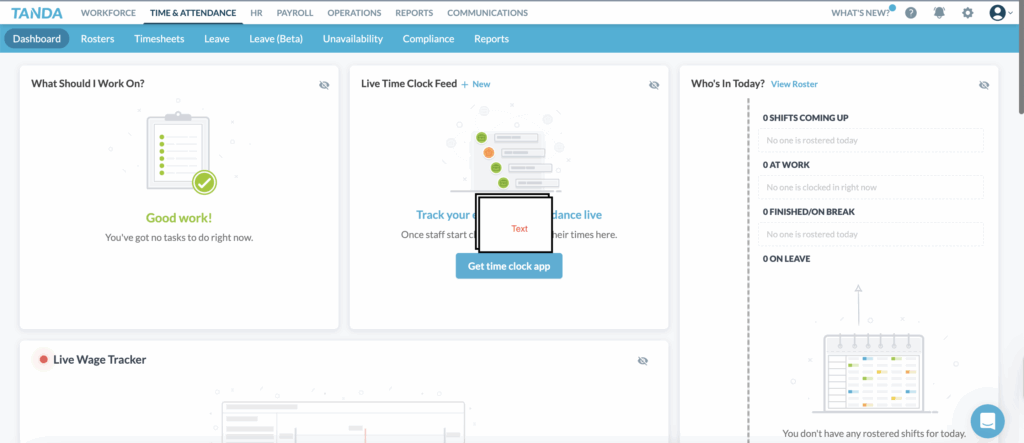
The employee dashboard is much simpler—it shows only timesheets and schedules, plus tabs for managing leave and availability.

Finding features is relatively easy, and all workflows can be completed in a few clicks. Most settings are just simple checkboxes, and I like that Tanda has a ‘What’s New’ section in its top navigation bar.
Overall, I think the learning curve is gentle, with no major complications.
A live chat widget gives instant access to the help centre and support reps, which is a big plus. However, help isn’t integrated across features via onboarding videos or an AI assistant.
For instance, the first thing you must do to use Tanda is add a location and then assign teams (e.g. marketing, finance or kitchen teams) to that location. However, since there’s no onboarding assistant, I had to use help centre documentation and play around to figure out how to do this, which took some extra time.
Unfortunately, I didn’t notice any accommodations for visually or hearing-impaired users.
Verdict: 7/10
Mobile app
The Tanda mobile app is fairly limited—it covers rostering, leave management and basic chat, but doesn’t include payroll or HR features. But the interface is clean, intuitive and easy to navigate, and I appreciated how quick it was to set things up.
However, I didn’t like that there is a separate app for time tracking—an inconvenience, specifically for employees with limited space on their phones. The time clock app allows employees (including admins) to track their shift time (admins monitor and approve timesheets from the main Tanda app).
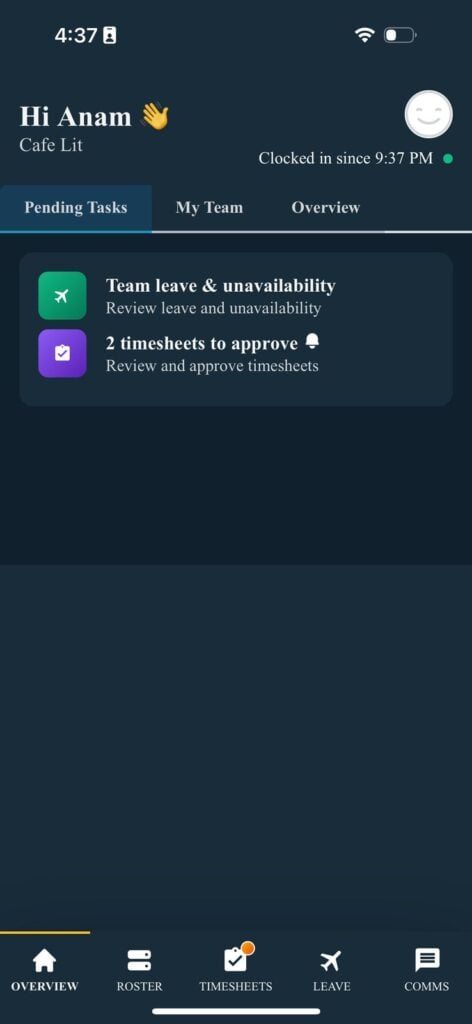
On the main mobile app, sending a company-wide announcement, claiming shifts or approving leave takes just a few taps.
But both apps lack offline functionality—users can’t log time or start shifts without an internet connection, which can be a challenge in low-connectivity areas.
| Menu Item | Admin | Employee | ||
| Website | Mobile App | Website | Mobile App | |
| Timesheet | ✅ | ✅ | ✅ | ✅ |
| Time Tracker | ✅ | ✅ | ✅ | ✅ |
| Calendar | ✅ | ✅ | ✅ | ✅ |
| Schedule | ✅ | ✅ | ✅ | ✅ |
| Expenses | ❌ | ❌ | ❌ | ❌ |
| Time off | ✅ | ✅ | ✅ | ✅ |
| Analysis | ||||
| Dashboard | ✅ | ❌ | ❌ | ❌ |
| Reports | ✅ | ❌ | ❌ | ❌ |
| Activity | ✅ | ❌ | ❌ | ❌ |
| Management | ||||
| Kiosks | ✅ | ❌ | ✅ | ❌ |
| Approvals | ✅ | ✅ | ❌ | ❌ |
| Projects | ❌ | ❌ | ❌ | ❌ |
| Team | ✅ | ✅ | ❌ | ❌ |
| Clients | ❌ | ❌ | ❌ | ❌ |
| Tags | ✅ | ❌ | ❌ | ❌ |
| Invoices | ✅ | ❌ | ❌ | ❌ |
| Settings | ✅ | ✅ | ✅ | ✅ |
Advanced settings to enable replies, track read acknowledgements and more are available. However, because of limited features and need for a separate time tracking app, I believe Tanda’s mobile app needs improvement.
Verdict: 5/10
Tanda Core Functionalities
Here are some of Tanda’s main features.
Employee onboarding and profiles
The employee onboarding feature is part of the workforce management module. It includes a customizable form for collecting essential employee information such as bank details, emergency contacts and tax numbers. You can add extra questions, and all data syncs directly to payroll—automatically connecting to your default super fund or allowing employees to use their own.
Admins/managers can fill out the onboarding details themselves or give employees self-service access. I liked that managers/admins had the flexibility to allow employee self-service, which saves time and effort and allows for better coordination.
With self-service onboarding, the employee can complete their profiles. You can also attach contracts, policies, onboarding materials or training documents. Tanda emails these to the employee, notifies you when they’re signed and stores them securely. Once onboarding is complete, an employee profile is automatically created.
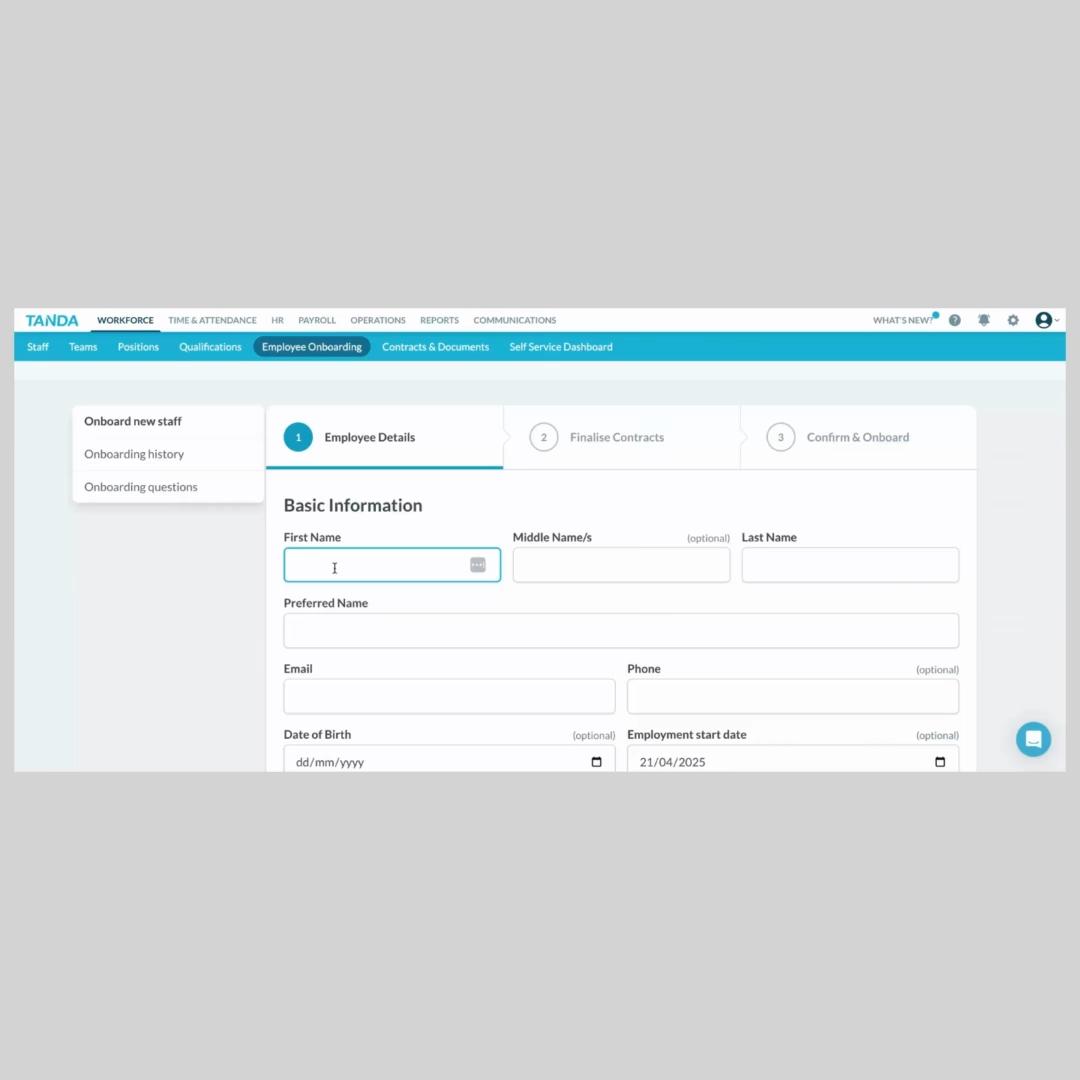
A profile has all the employee’s information in one place, including performance reviews and leave. It also includes a chat button you can use to talk to the employee instantly—it isn’t anything over the top, but I liked the simplicity and workflow.
A downside? You can’t customize the onboarding workflow beyond adding questions to forms—while some competitors offer highly customizable workflows with checklists, media and more.
Verdict: 9/10
Rostering
I like the rostering feature because it has everything you need to schedule shifts efficiently. To create rosters, first select a team, then select a shift time on the schedule and assign it to an employee from that team using a dropdown. You can then add breaks and more. You can also set hourly rates and set notifications for overtime, clock-ins/outs and vacant shifts.
On the left of the rostering feature, you’ll find options for quickly building rosters using templates, regular hours or common patterns. Tanda can also generate schedules based on your employees’ regular working hours and your budget constraints.
However, these auto-scheduling features are limited compared with competitors. For instance, Connecteam offers an auto-assign feature that automatically assigns vacant shifts and creates schedules considering overlapping shifts, time-off requests, fairness in distribution and even employee qualifications. I think this puts Tanda at a disadvantage, as those kinds of features can save users tons of time.
The left side also has an option for ‘Tools’. You can view demand predictions, shift acceptance and shift swaps—and edit budgets. You can also publish schedules with a click.
Clicking on an employee in the roster opens up additional options such as recording leave, adding on-call time or assigning additional shifts.
I wish there was an onboarding guide on the roster page—I had to wing it.
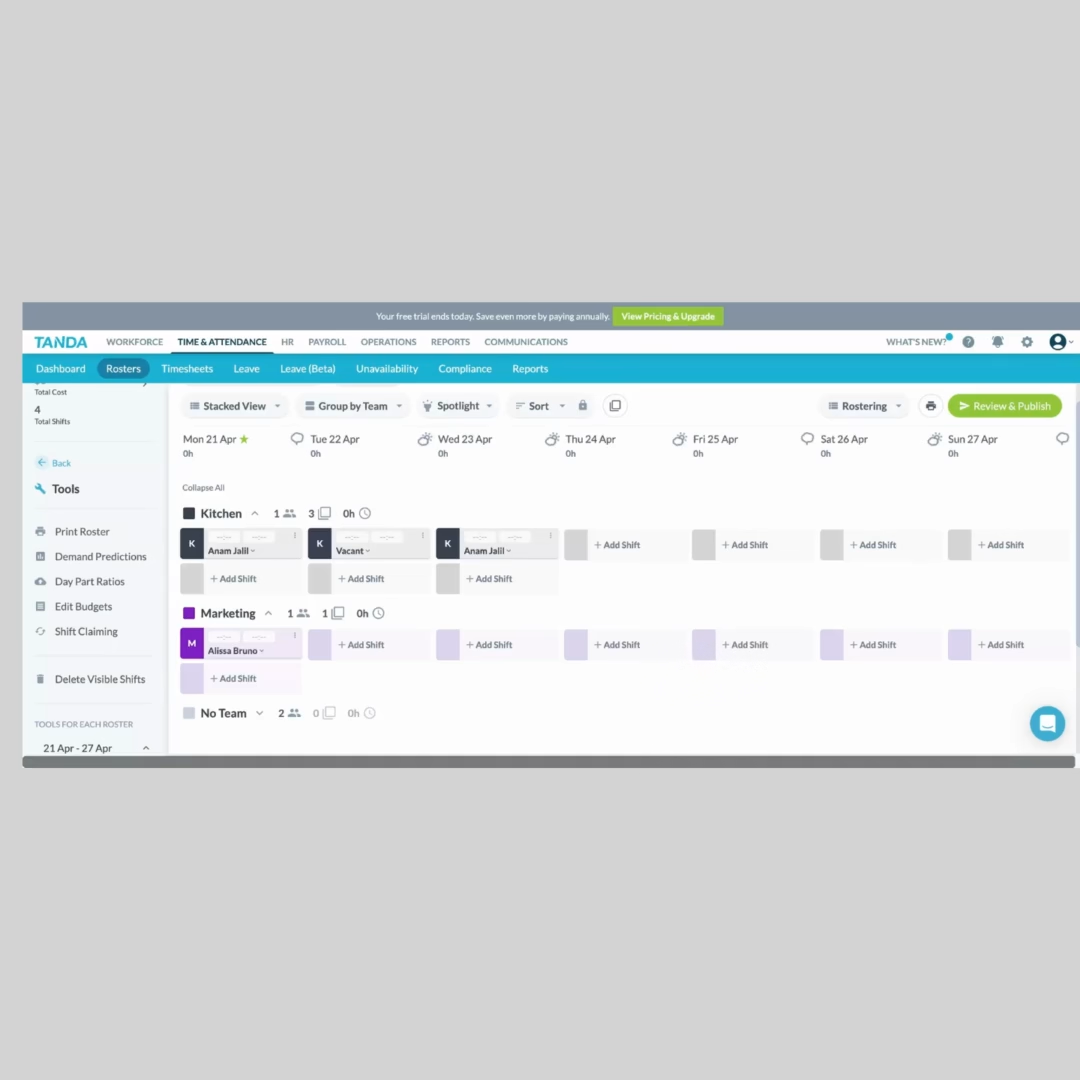
Verdict: 7/10
Compliance and award interpretation
Tanda’s compliance and award interpretation features are what make it a strong choice for Australian businesses employing hourly workers—especially those covered by modern awards. However, if your workforce is mostly salaried, doesn’t need to track breaks or shifts and isn’t covered by awards, Tanda may not offer much value over other competitors.
The compliance tools are nothing fancy, but they’re effective. You can quickly set rules—like max hours, minimum break times and required certifications—and Tanda will automatically block employees from being assigned to shifts/teams they’re ineligible for.
You can also choose from award templates to automatically calculate hours, pay, and entitlements. This keeps you compliant without hassle.
Verdict: 10/10
Time clock and timesheets
The time clock app is simple: Employees clock in, their locations are recorded with GPS, and you can enable their phone cameras to take pictures of them if needed (to prevent time theft). Employees just tap to start breaks or clock out.
However, I think the app feels a bit clunky. Here’s why:
When an employee profile is created, each employee is assigned a time clock PIN. With every step I took on the time clock app, it kept asking for my employee PIN, which I found frustrating. For example, I’d test a setting and be asked for my PIN, then I’d hit ‘Break’ and be asked for my PIN again. I think once an employee is signed in with their PIN, they shouldn’t be asked again unless they’re changing a very important setting.
Also, I experienced a glitch: When I pressed ‘Start’ to begin tracking time, the time clock showed me as being clocked out. My time was recorded, but the experience was confusing.
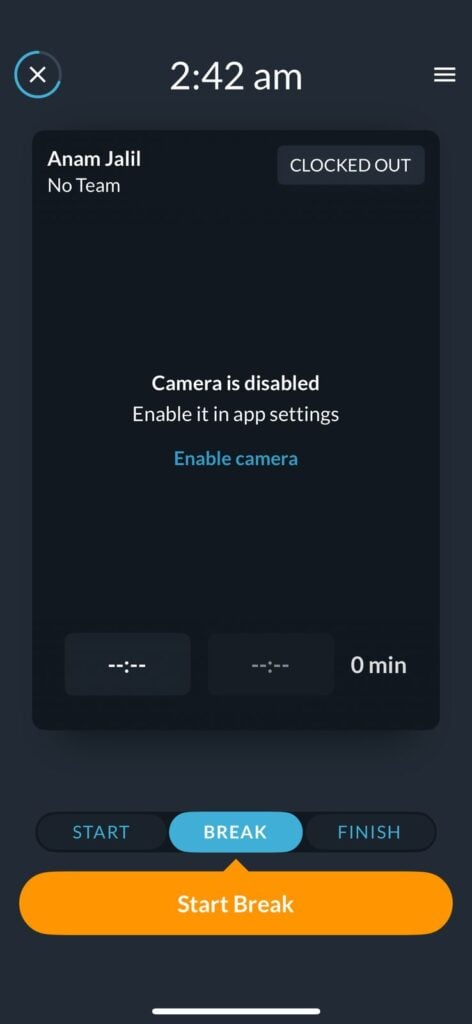
I appreciate that Tanda auto-generates timesheets and flags issues like overtime, lateness or breaches of legal working hours. You can use these timesheets for payroll.
However, users report issues with the Xero payroll integration.
Verdict: 5/10
Recruitment and training
I couldn’t test Tanda HR features, as they aren’t available during the trial—so I used user reviews and the Tanda website to briefly review them.
Tanda Hire offers an ATS system where you can post your ad, review applications and hire and onboard. The system seems simple to use.
However, the lack of reports is a big minus. While you can track job ads and candidate progress, you don’t get in-depth insights into performance metrics like candidate quality, time-to-hire, etc.
You can create custom training modules, provide access to reading material and policies and track performance. Training is available in-app, but I am not sure where that pops up, as I didn’t see it—perhaps because I was on the free trial.
Training is more focused on onboarding and compliance than employee development. Also, although you can add external material and customize a course flow, you can’t issue or track certifications, create quizzes or in-app videos or break a course down into bite-sized lessons—unlike you can with Connecteam.
Verdict: 5/10
Tanda Security Features
Tanda takes user data security seriously. It offers two-factor authentication, so even if someone gets one of your users’ passwords, they’ll still need a code to access the account. Role-based access ensures users only see and do what they’re authorized to.
Passwords are securely stored using bcrypt with salting (which adds random data to passwords so identical passwords are stored differently and harder to crack). All transmitted data is encrypted. Each company’s data is isolated, and Tanda conducts regular security audits to maintain high standards. It’s also GDPR-compliant—ideal for businesses prioritizing privacy.
Overall, Tanda’s security features are strong and give users confidence in their data protection.
Verdict: 10/10
Tanda Reporting & Analytics
Tanda’s dashboard contains some default reporting features that include a live wage tracker, team schedule, pending tasks and team attendance, as well as a live time clock that shows admins all employees who’ve clocked in.
You can add custom widgets to your dashboard for various reports, including: Actual versus Scheduled Hours, Missing Agreed Work Hours and more. Adding a report to your desktop is a 1-click procedure.
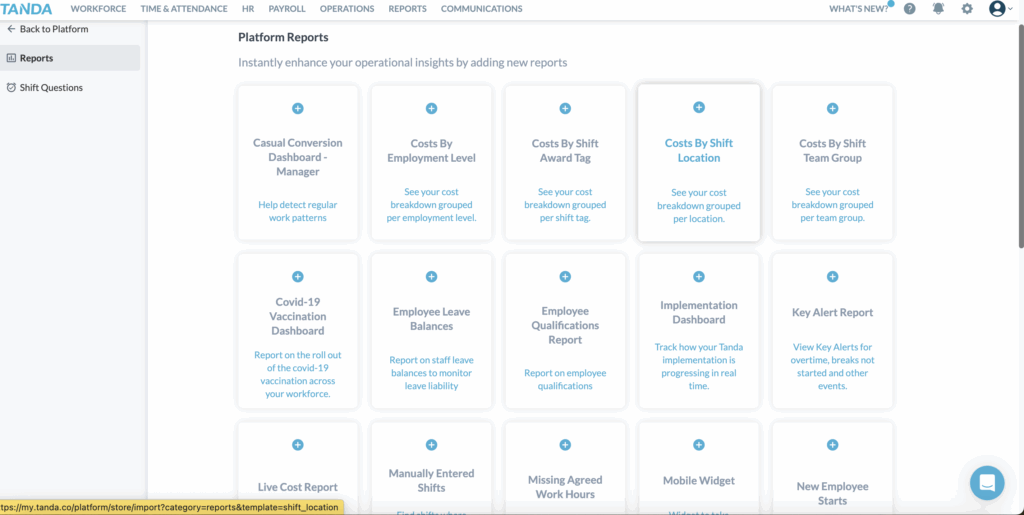
The tool’s reporting function is broken into reports for time and attendance, employees, payroll, compliance and cost.
I find the reporting feature comprehensive and detailed—plus, it’s simple to use. However, unlike Connecteam, detailed reports aren’t available via the mobile app. That might pinch admins who want a 24/7 bird’s eye view.
That said, I appreciated that the reports offer actionable insights, so managers can take data-driven, informed decisions.
Verdict: 8/10
Tanda Customer Support
Tanda’s customer support isn’t directly available on the website to those who haven’t signed up. To find out pricing, request a demo, ask a question or start a trial, you must fill out a form and wait for a support rep to get back to you. The rep should respond promptly within Australian business hours, though timings aren’t specified. But first, you’re sent an automated email with basic information.
When I emailed Tanda’s support team, they replied within 24 hours.
Once you start a free trial, there’s a live chat widget on your dashboard with an auto assistant named Dan that answers instantly—I found this useful. I also appreciate that the website has a full-fledged help centre with relevant articles. The AI assistant points you towards help centre articles that’ll answer your queries if you require step-by-step assistance.
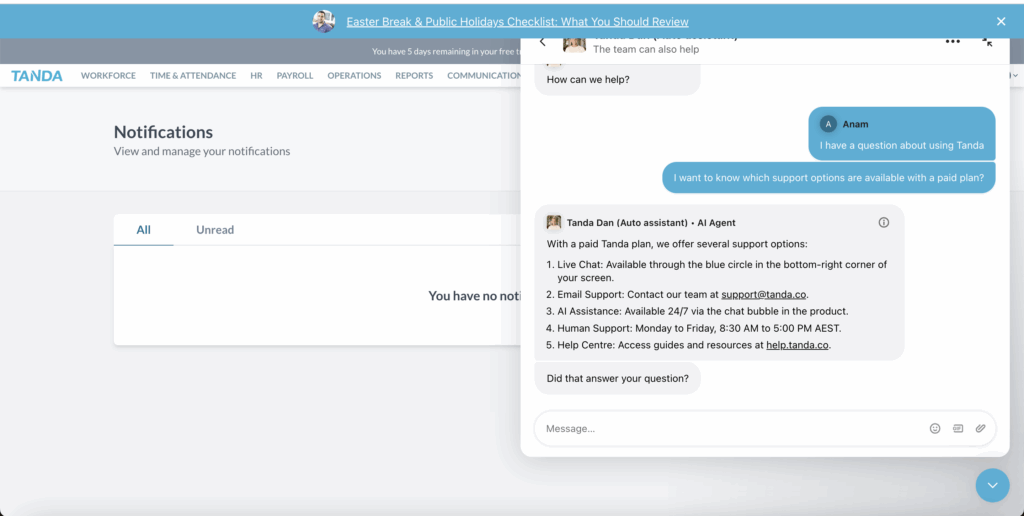
You also have access to live human support from 8:30 am to 5:00 pm AEST with a paid plan, which is accessible via the in-app chat feature.
I found having to speak to a sales rep for everything a bit frustrating, and Tanda didn’t have demo dates available for another 1.5 weeks when I messaged. So I asked them for a free trial, and they immediately complied, which I appreciated.
Ultimately, I found the support responsive, but I wish prospective customers could sign up for a free trial on the website. Also, I wish Tanda had phone support.
Verdict: 8/10
What are Tanda’s Review Ratings from Review Sites?
(As of June 2025)
Capterra: 4.4/5
G2: 4.7/5
Software Advice: 4.4/5
TrustRadius: Not enough reviews
GetApp: 4.4/5
Google Play Store: 3.6/5
Apple App Store: 4.7/5
Tanda App Review
Despite its feature shortcomings and limited mobile functionality, Tanda is a good solution for Australian businesses with hourly staff that must comply with complex award interpretations and Fair Work labour laws.
While it comes at a higher price point, it streamlines scheduling, time tracking and payroll processing for award-covered teams, which some may consider value for money.
However, for smaller businesses, those with salaried staff or those not governed by Australian awards, a more cost-effective and flexible workforce management tool may be a better fit for their operational needs.
Connecteam: The Better Tanda Alternative
Connecteam is an all-in-one staff management solution that offers advanced time tracking, attendance, HR and payroll features. I think it stands out in several key areas compared with Tanda.
Both platforms package their services per module, but Connecteam takes the lead with more transparent and affordable pricing. Connecteam’s Basic plan includes up to 30 users for a flat rate of just $29 USD per month.
And I appreciate how small businesses can benefit from Connecteam’s free-for-life plan, which includes all features for up to 10 users. Unlike Tanda, there’s no need to speak with a sales rep to get started.
What truly sets Connecteam apart, I think, is its comprehensive, all-in-one platform. Connecteam covers every aspect of staff operations from scheduling and document management to training, performance tracking and task management. In contrast, Tanda lacks some advanced training features and task management features.
Connecteam also offers a superior user experience. Its bright, modern interface is intuitive, mobile-first, and backed by step-by-step onboarding guidance. The fully functional mobile app includes:
- Employee scheduling
- Employee time clock app with GPS
- Training features
- Live insights
- Team instant messaging
- Team documents
- Digital forms
…and more!
Additionally, Connecteam is highly scalable and customizable, making it an excellent fit for businesses at any growth stage.
FAQs
Yes, Tanda offers a 14-day free trial, but you must contact sales and fill out a form to get access. The trial doesn’t give you access to all features but provides a reasonable overview of the workforce management features.
Tanda isn’t HIPAA compliant because it’s designed for Australian businesses, and HIPAA is a US healthcare data privacy regulation. However, it aligns with Australian privacy laws and adheres to the Australian Privacy Principles for handling personal information.
